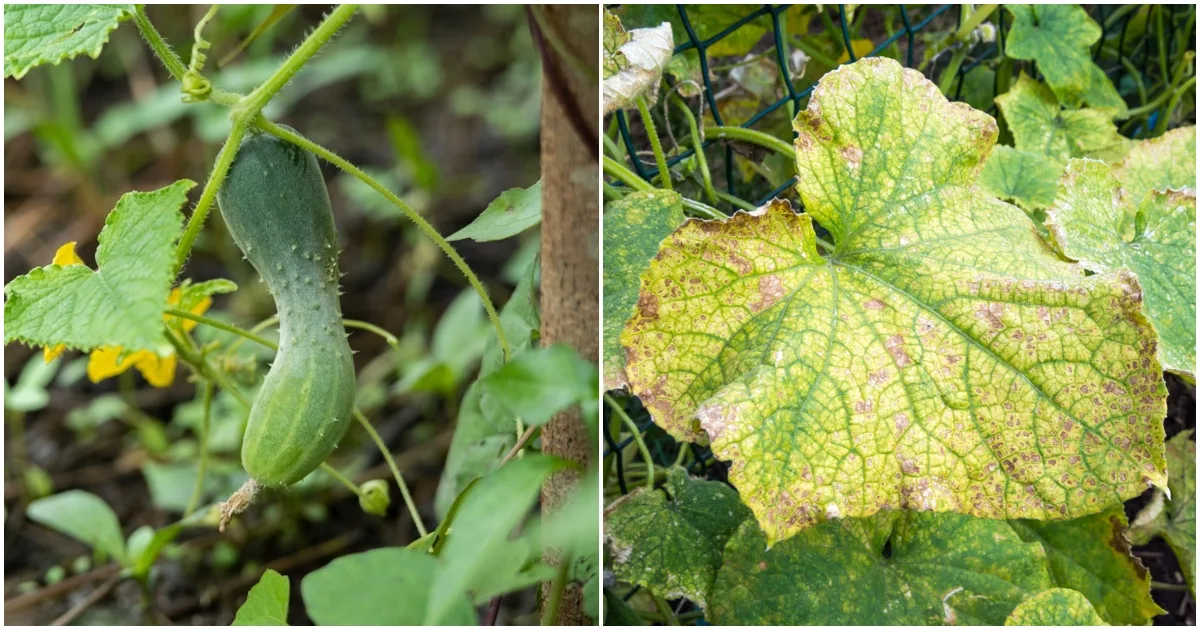
If there is one vegetable that screams summer, it’s cucumber.
Cool salads don’t seem to be complete without fresh juicy cucumber slices, and they make great additions to summer smoothies. At-home spa days are among the first images that pop up when thinking of these delicious vegetables.
No home vegetable patch is complete without these fresh, crispy vegetables. Cucumbers are extremely beginner-friendly and thrive in a variety of climates. You’re also spoiled for choice when it comes to picking different varieties, which only adds to their charm.
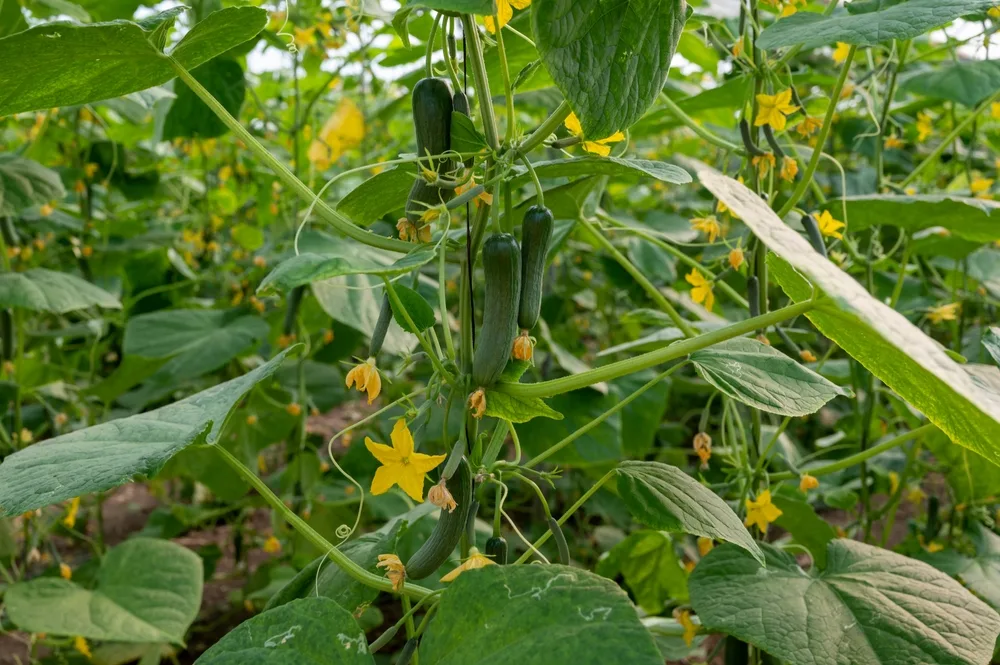
While cucumbers are easy to care for, they aren’t always problem-free.
Even the most seasoned green thumbs could encounter problems when growing these delicious vegetables, from diseases to pests and more.
These problems may seem daunting, but, luckily, most are easy to fix and, more importantly, easy to prevent.
General Cucumber Care
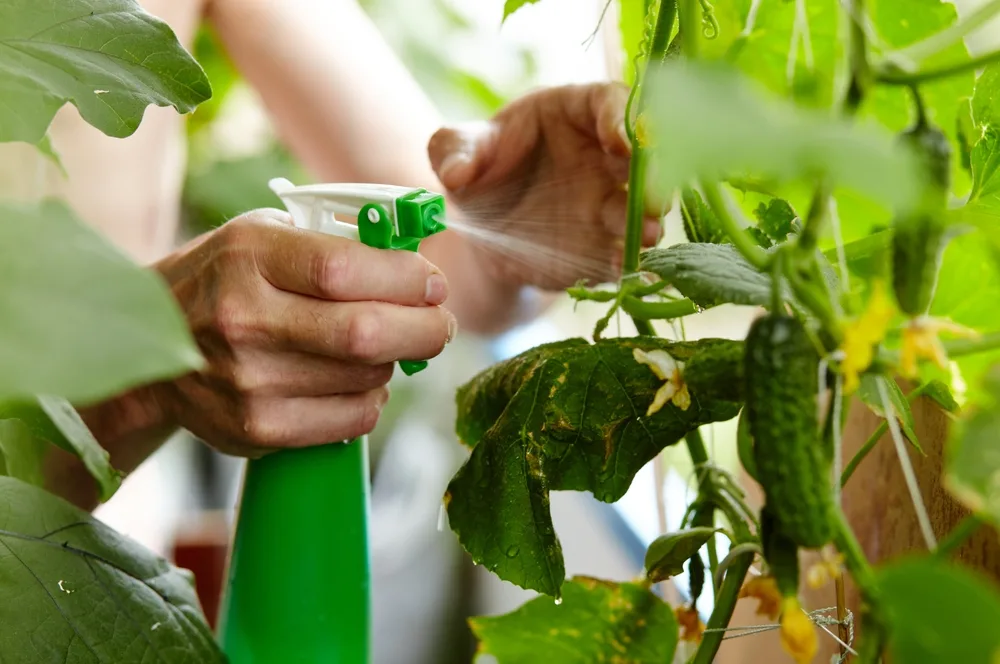
Before we get into the problems you may face when growing cucumbers, let’s go over how best to care for them.
Cucumbers thrive in many conditions, growing in USDA zones 4 – 11. They love sunlight and often produce the best fruit in warm and humid environments. However, cucumbers will still flourish in drier conditions.
Cucumbers grow best in slightly acidic, well-draining soil rich in organic matter. Throw some mulch on top of the soil and these vegetables will be happy all season long.
The only thing cucumbers are fussy about is water. This is no surprise considering these juicy veggies are mostly water.
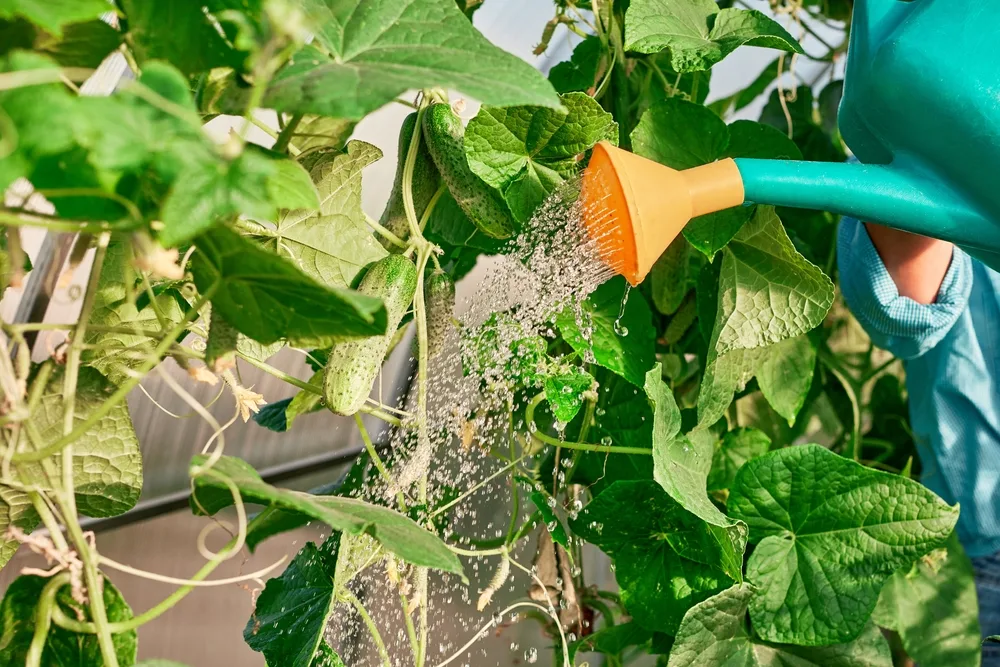
These perfect summer vegetables grow best when they’re watered deeply and consistently. As long as the soil remains moist, but not soaking, your cucumber plants will produce the juiciest cucumbers you’ve ever tasted.
As easy as it may seem to take care of cucumbers, you may still face several issues. If you notice your cucumber plant showing any signs of stress, it may be any one of these cucumber problems.
1. Little to No Cucumbers
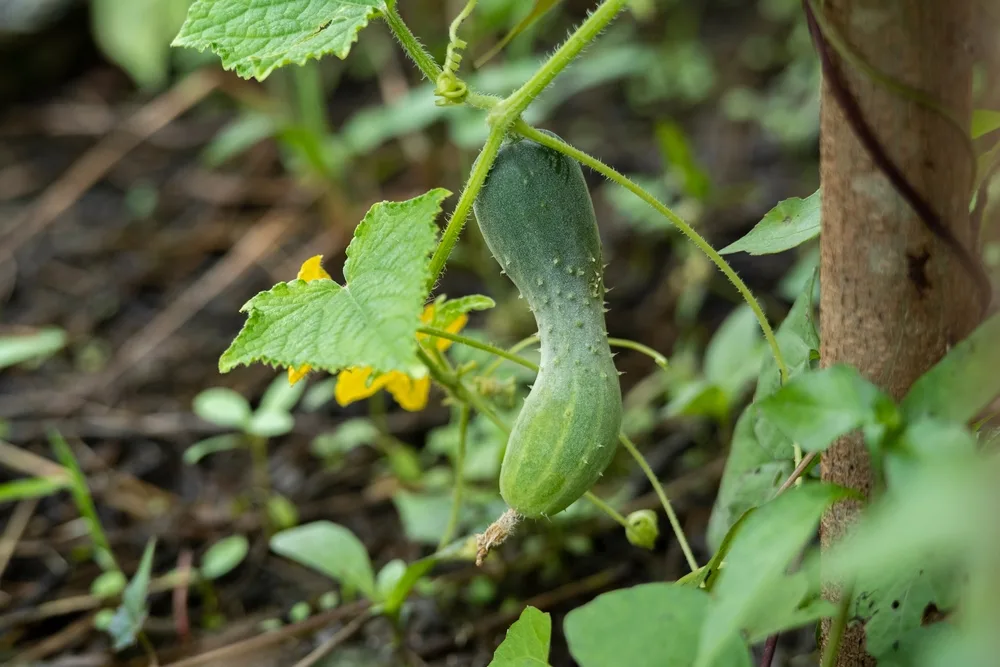
Cucumbers, like most fruiting plants, need to produce flowers before they fruit. They have both male and female flowers that have different jobs. The former produces pollen, while the latter eventually become the tasty green vegetables we know and love.
Cucumber plants often produce plenty of flowers, but they rely heavily on pollination to produce lots of crunchy vegetables. Several pollinators including bees and hummingbirds play a huge role in the production of cucumbers.
Often, the reason for a lack of fruit on your cucumber plant is as simple as poor pollination.
Several factors could lead to pollinators not doing their job, most of which are due to weather. Excessive heat, cold, or even rain could keep bees and other pollinators at bay, resulting in no natural pollination taking place.
This problem is easily rectified. All you need to do is play bee and pollinate your cucumber plants yourself.
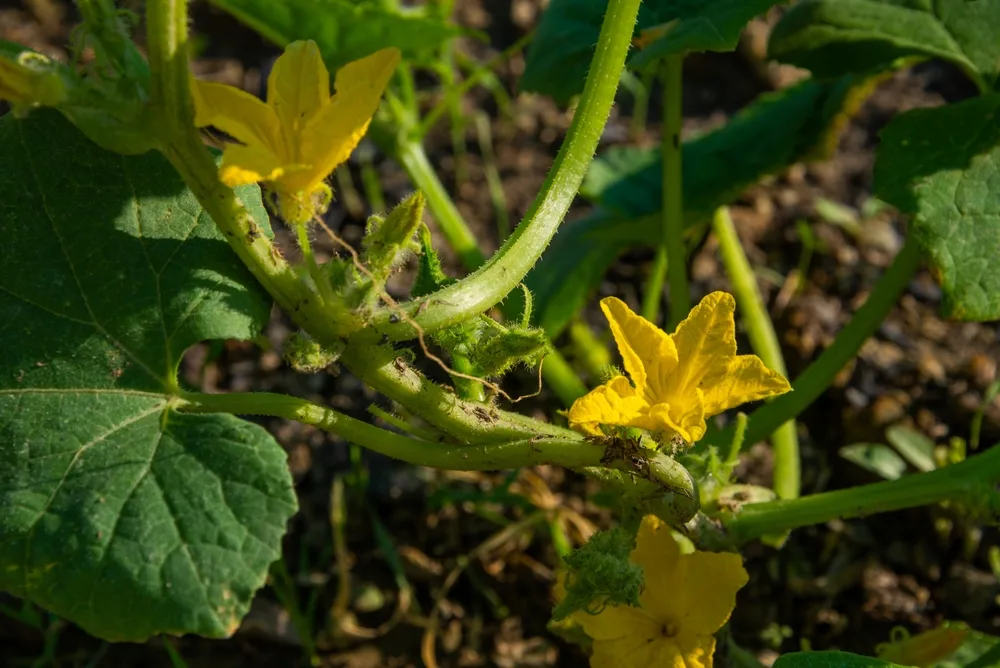
Take a small paintbrush and brush the inside of one of the male flowers – they’ll be filled with the much need pollen. From there, gently paint the inside of the female flowers with the pollen-filled paintbrush.
A lack of cucumber fruits or flowers could also be a sign of stress and self-preservation. Several things could stress your cucumber plant out – let’s take a look.
2. Target-shaped Spots – Alternaria Leaf Blight
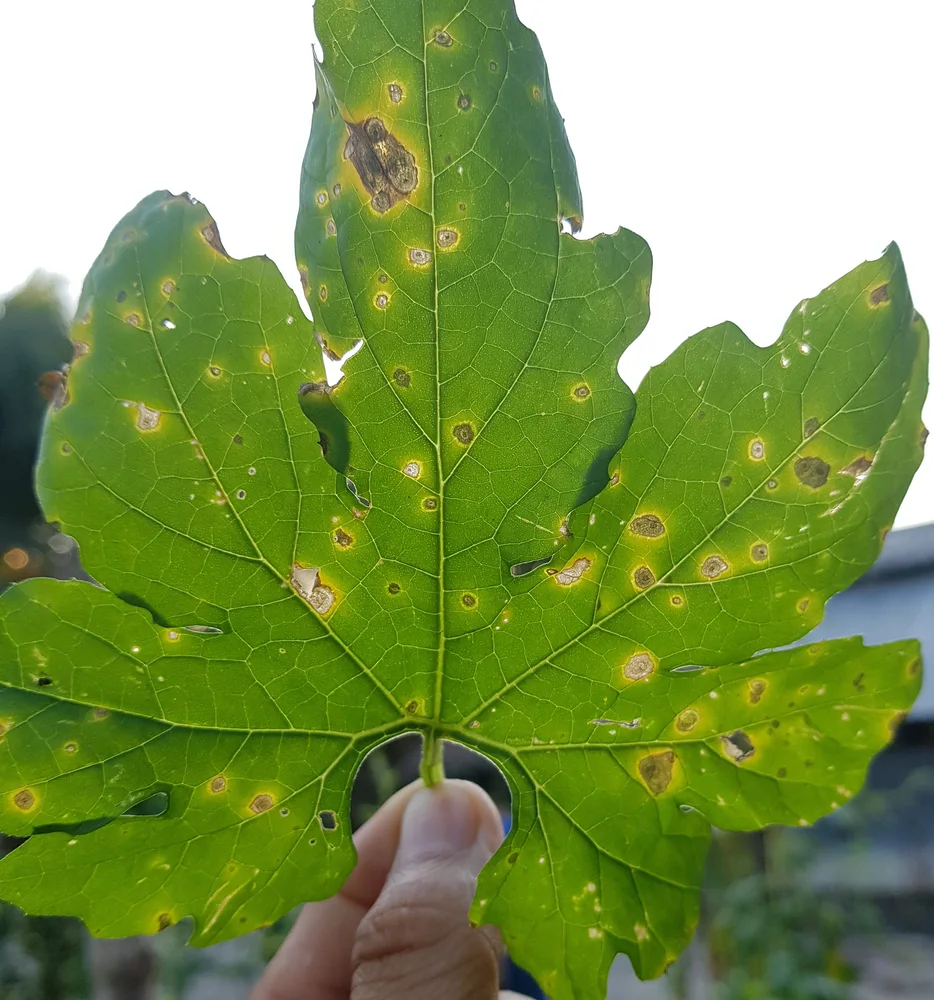
Alternaria leaf blight is a well-known fungal disease that commonly affects cucumbers, melons, and other members of the gourd family.
Once this fungus takes hold, it’s difficult to shake. Older, lower-lying leaves typically show the first signs of infection – which pop up as small, brown spots. Yellow, halo-like rings usually form around these spots.
As the disease spreads, these spots become irregular and sometimes develop smaller, tanned spots in their centers, like targets.
If left unattended, alternaria leaf blight can cause cucumber plant leaves to brown, curl and eventually die off. While this disease doesn’t typically attack cucumber fruits, they too can suffer. The lack of leaves exposes the vegetables to direct sunlight, usually resulting in sunscald.
The leaf loss also means the plant can’t photosynthesize as effectively, which ultimately results in a smaller, meager harvest.
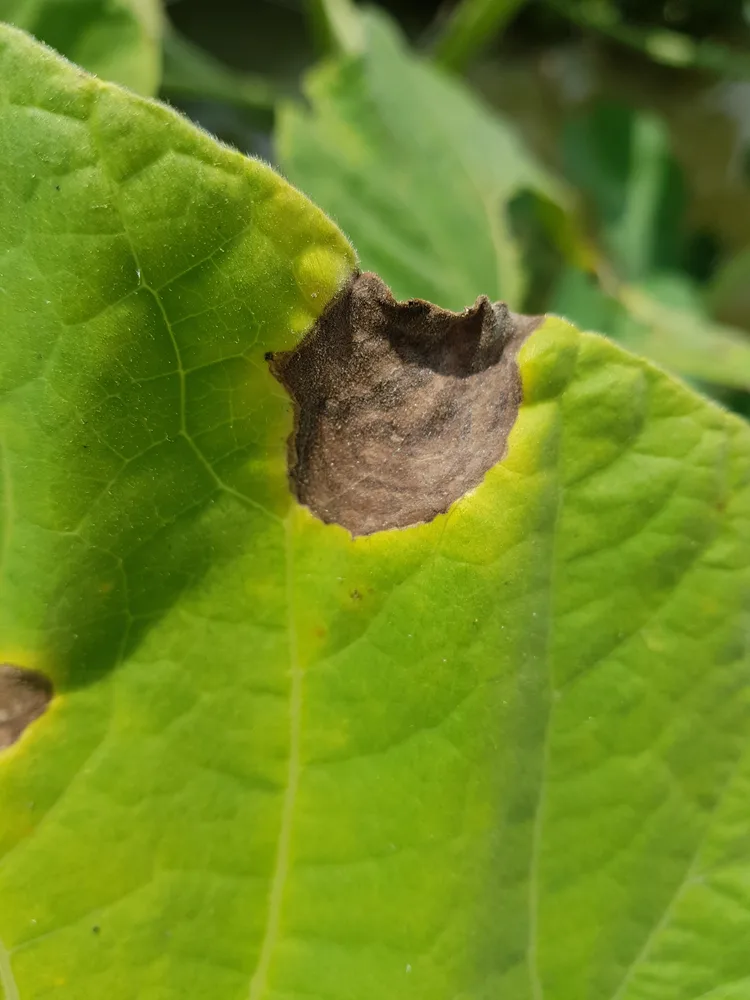
Sometimes, it can result in the death of the plant.
Alternaria leaf blight thrives in moist, humid conditions and is spread by wind and splashing water. Its most devasting characteristic is its ability to overwinter in the soil and on plant debris.
Prevent alternaria leaf blight from ever taking hold by practicing good garden hygiene and the correct watering methods. For example, always remove old plant debris from around your cucumber plants and avoid watering your plants from overhead.
Once spotted, it’s best to remove any infected leaves and stems to stop the fungus from spreading. Natural fungicides also work wonders in controlling this disease. A homemade spray of baking soda and vinegar also has the potential to help your cucumber plant, but only in the prevention or the very early stages of the disease.
If most of your cucumber plant is riddled with fungus, you will, unfortunately, need to destroy your plant. You’ll also have to treat or replace your soil to avoid spreading the problem to the next plant.
3. Sunken Spots On Leaves And Fruits – Anthracnose
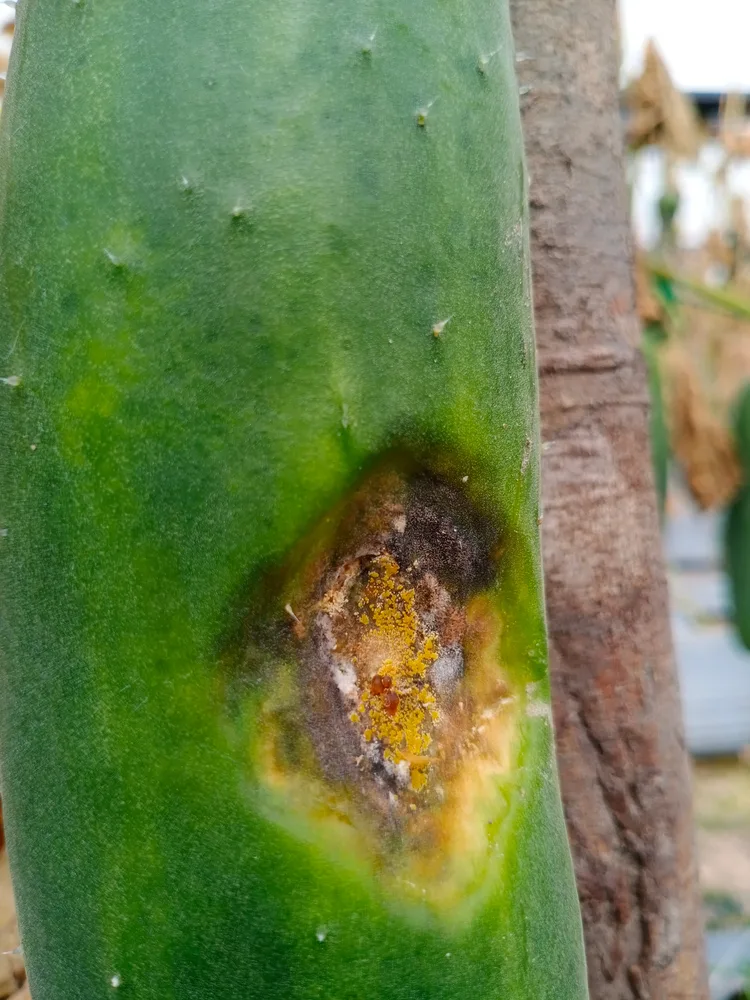
Anthracnose is another fungal disease. Unlike alternaria leaf blight, however, anthracnose can be far more devastating. This destructive disease commonly latches on to cucumbers and several other vegetables, fruits, and even trees.
Anthracnose grows and thrives in moist, humid conditions and spreads rapidly during rainy seasons.
The first symptoms of an anthracnose infection appear on the leaves of cucumber plants. Initially, small yellow or brown water-soaked spots develop across the leaves, and as the disease worsens, these spots grow. In most cases, these spots also darken and become sunken.
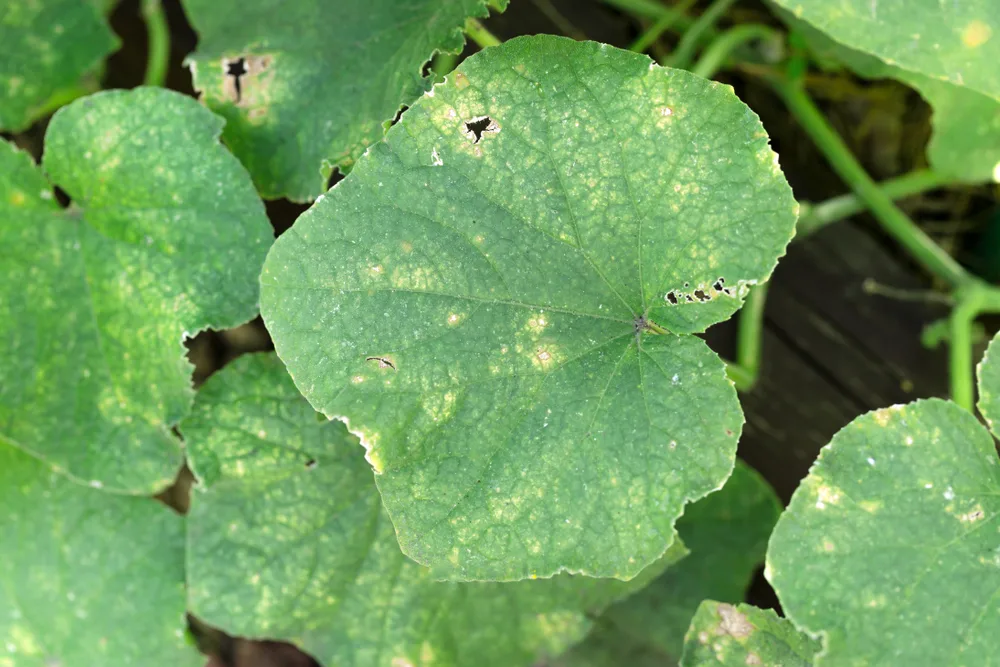
Eventually, entire leaves become covered in the fungus, resulting in leaf drop.
Unfortunately, anthracnose also attacks the stems and cucumber fruits, along with new growth. On fruits, anthracnose spots are sunken and black with pinkish centers. These pink centers are filled with clusters of anthracnose spores.
The best way to control anthracnose is to remove and destroy any infected leaves, stems, and vegetables. However, if the disease has taken hold of your cucumber plants, there isn’t much you can do. You may need to pull up the plant and destroy it.
Luckily, there are several ways to prevent anthracnose from infecting your cucumbers and other plants. You can plant disease-resistant cucumber varieties, like the slicing variety ‘Thunder.’
You should also avoid overhead watering methods. Instead, opt for drip watering methods, which prevent water from splashing onto low leaves.
Anthracnose, along with several other diseases, can also be prevented through crop rotation. It’s generally advised to rotate cucumber plants every two to three years.
4. Holes In Leaves And Fruits – Cucumber Beetles
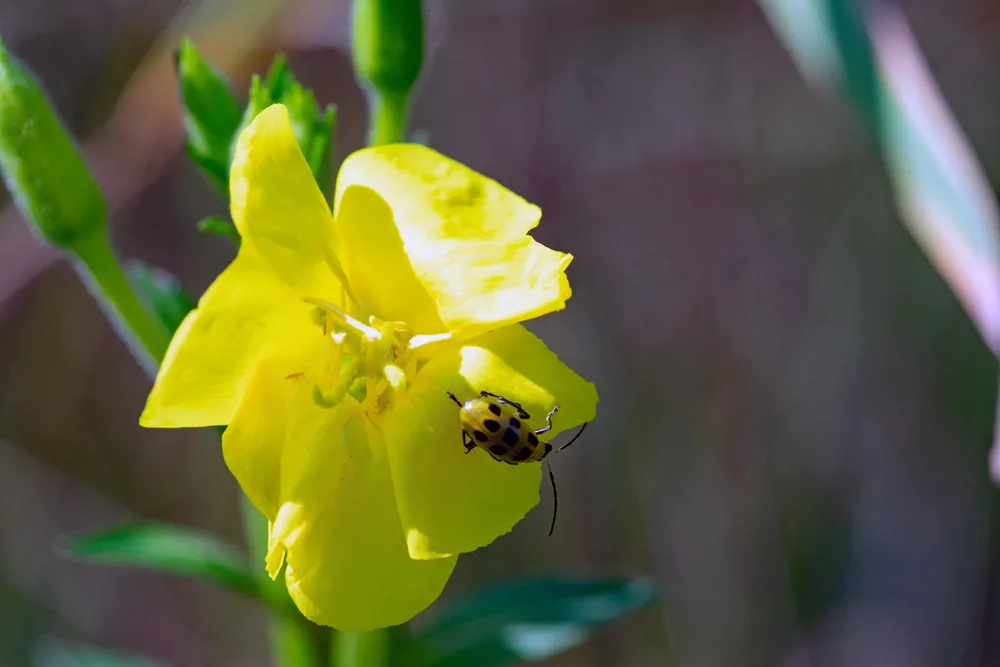
As the name suggests, cucumber beetles are common pests that plague these summer vegetables. Despite these pests being common, they’re unfortunately one of the hardest to get rid of.
There are two types of cucumber beetles – the striped cucumber beetle, and the spotted cucumber beetle. Both types munch away on leaves and cucumber flowers, leaving behind trails of holes.
Sometimes, cucumber beetles can venture to the fruits. Cucumber beetle larvae, on the other hand, nibble on cucumber plant roots.
The constant munching of foliage by adult beetles can cause irreparable damage to your cucumber plant. It stunts growth and causes yellowing and wilting leaves. In most cases, fruit production is severely affected.
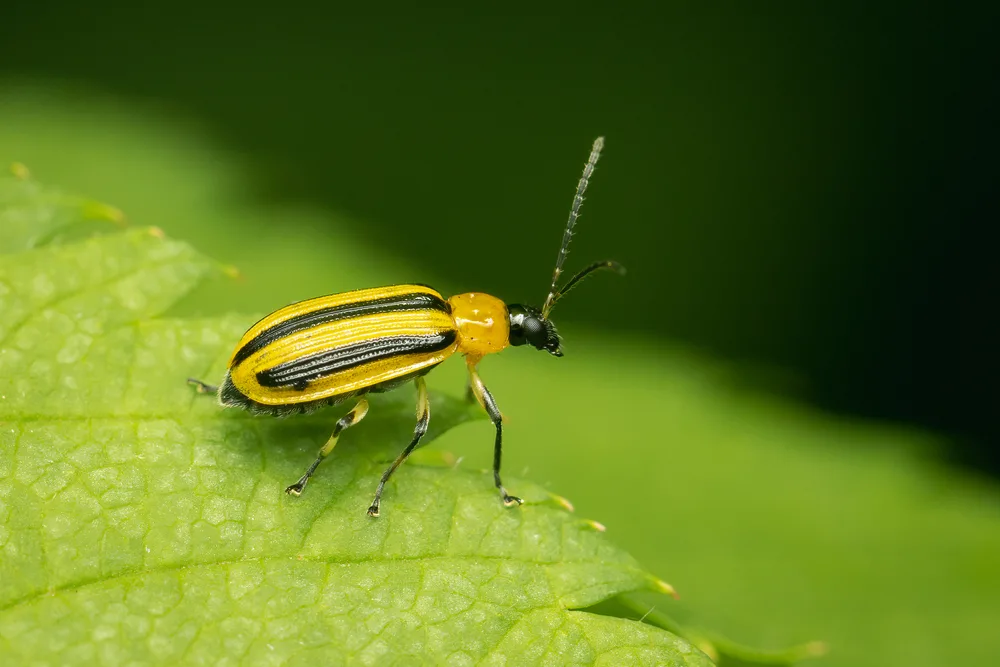
These pests can also carry and spread many diseases, including bacterial wilt, that will destroy cucumber plants.
If you spot these pesky pests, it’s best to get rid of them and try preventing them from attacking your cucumber plants.
You can use traps, like yellow sticky traps, to catch cucumber beetles – but be careful as these can also trap beneficial insects. Row covers are also a great way to keep cucumber beetles and several other pests off your crops.
You could also try to pluck them off your cucumber plants, but they’re difficult to grip. If these pests continue to slip between your fingers, try knocking them into a bucket of soapy water or onto a sheet of cardboard.
5. Colored Spots On Leaves – Angular Leaf Spot
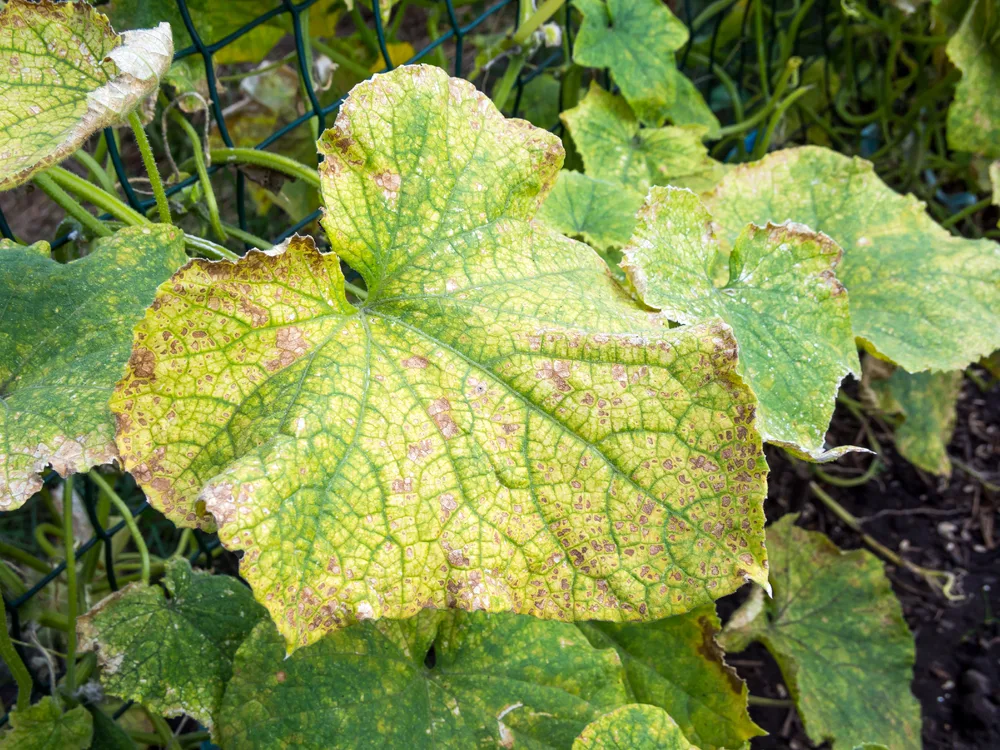
Angular leaf spot is another disease that can leave your cucumber plants riddled with strange, life-threatening spots.
Angular leaf spot is caused by the bacterium Pseudomonas syringae pv. Lachrymans. It can be a common problem facing cucumber gardeners who don’t choose disease-resistant varieties. If left untreated can quickly lead to fruit rot.
Angular leaf spot takes hold and spreads in hot, wet, and humid conditions. Initially, small spots appear across cucumber leaves, like most other spot diseases. These spots look like water-soaked spots and expand as the disease progresses, but they never cross leaf veins, resulting in a tile-like appearance.
Eventually, these spots develop a white, powdery substance which dries out and tears through the plant’s foliage.
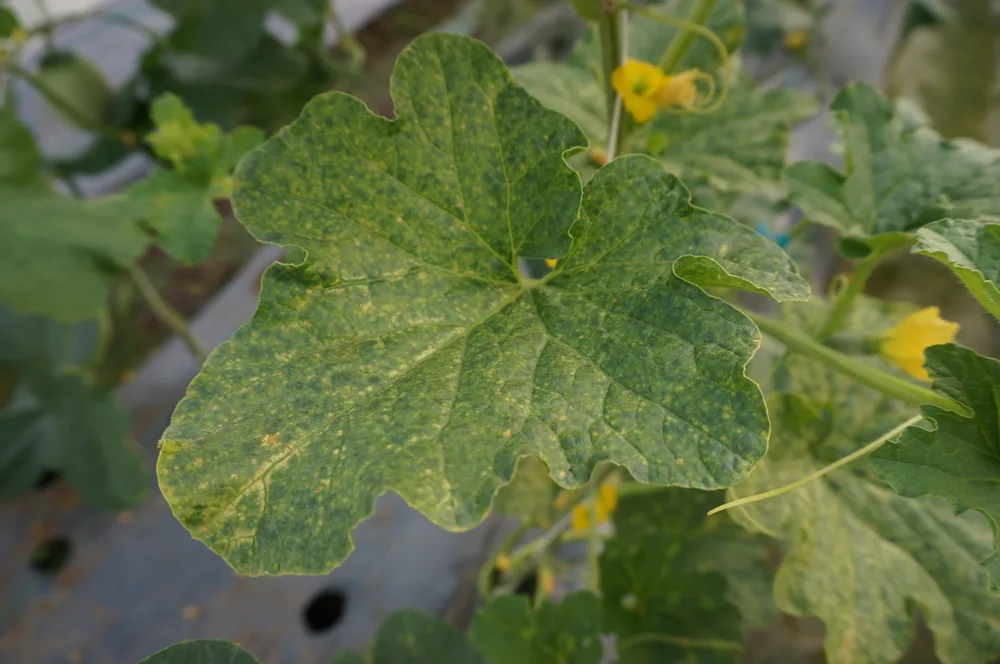
In severe infections, water-soaked spots appear on stems and cucumbers too. They also dry and form a white substance and eventually cause internal rot of our favorite summer vegetables.
Angular leaf spot is usually introduced into gardens through infected seeds and is easily spread through splashing water and carrier insects. Therefore, the best way to ‘cure’ this disease is to prevent it from even taking hold.
Opt to plant disease-resistant varieties and start practicing good garden hygiene, like only using drip-watering methods and not handling your plants during very wet conditions.
6. Wilting Vines – Bacterial Wilt
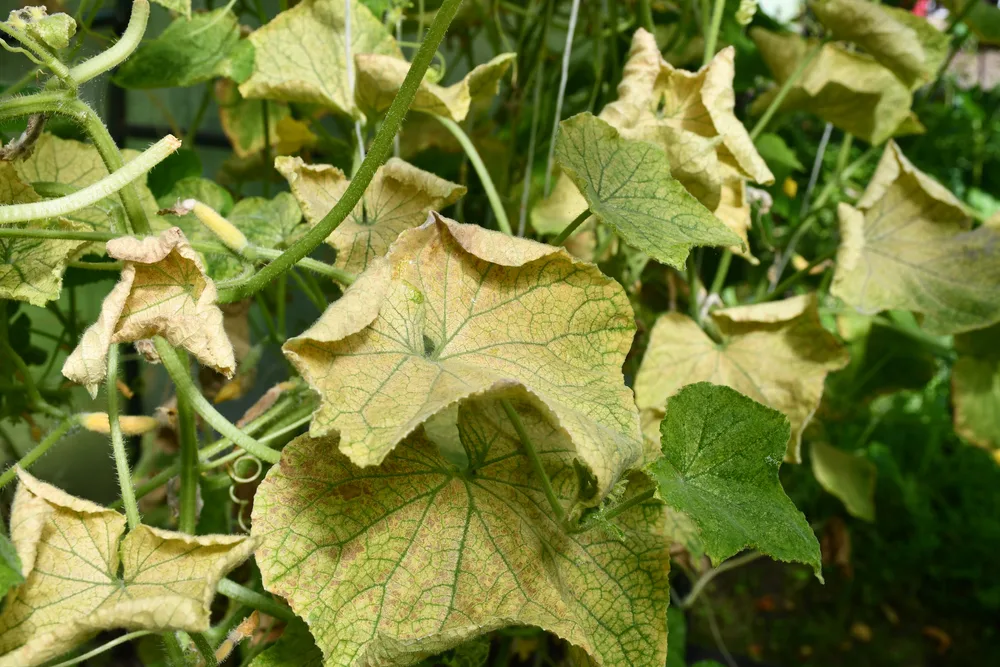
Bacterial wilt is a devastating disease that tomato gardeners might be familiar with. It attacks several other vegetables too, including cucumbers.
Erwinia Tracheophyta is the bacterium that causes bacterial wilt and is usually introduced by cucumber beetles and other pests.
One of the first signs of a bacterial wilt infection is the wilting of vines, regardless of the amount of water the plant receives. Cucumber leaves also seem to appear dull, eventually becoming yellow and brown over time.
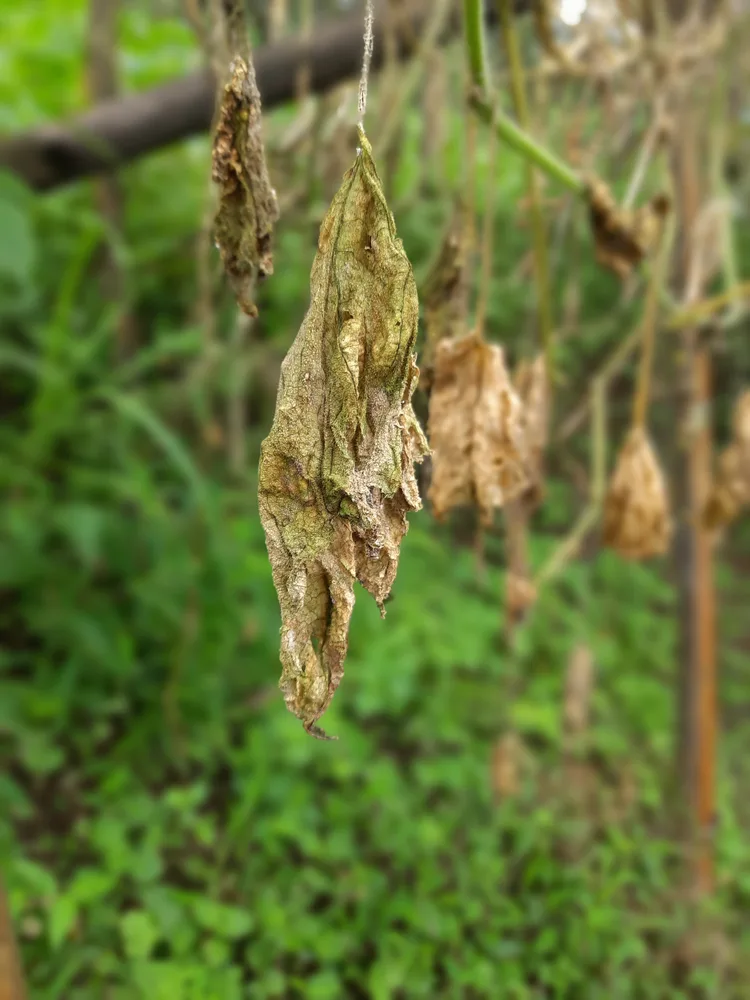
If you suspect a bacterial wilt infection, you can easily test your cucumber plant by cutting a wilted stem near the base.
If a strange, sticky substance oozes from the cut, it’s a bacterial wilt infection.
While there is no cure for bacterial wilt, there are several ways to prevent this disease from attacking your cucumbers.
One of the first steps is to get rid of cucumber beetles and prevent them from settling on your plants. You can also opt to plant one of the several resistant cucumber varieties.
7. Yellow And Red Spots On Leaves – Spider Mites
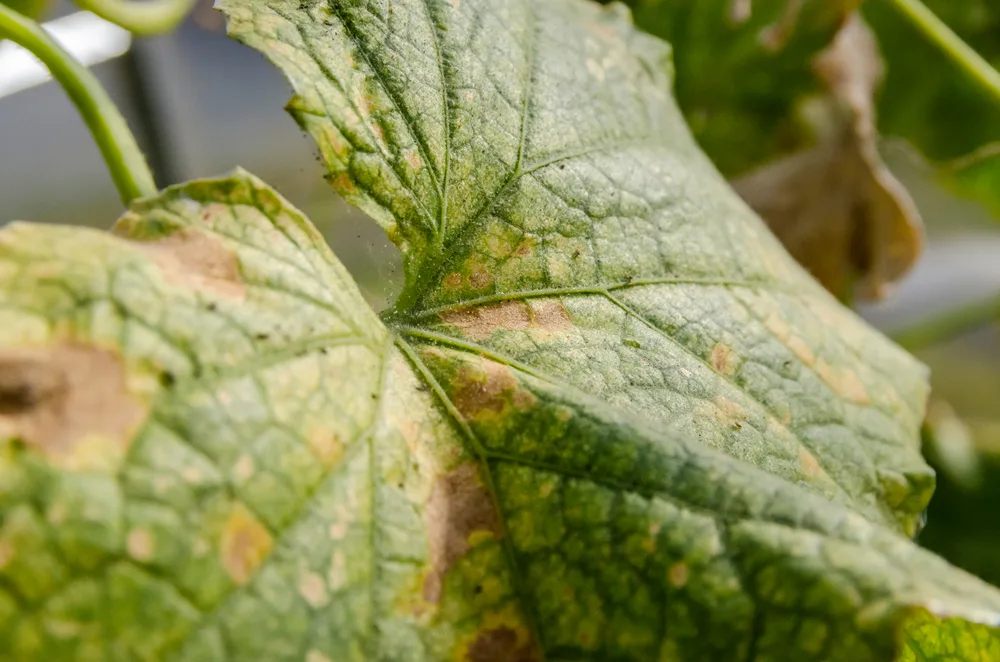
Spider mites are a tiny, almost invisible little pest that wreaks havoc on homegrown vegetable patches.
There are several different types, but the two-spotted spider mite favors cucumber plants over other vegetables. They thrive in hot, dry weather and make the underside of cucumber plant leaves their home.
Spider mites feed on the plant cells of leaves, resulting in odd yellow and red spots cropping up across the foliage. These spots range in size and usually begin to appear on the upper sides of leaves. Eventually, the underside of leaves becomes tan and dry out.
Once a spider mite infestation takes place, they can kill off cucumber plants very quickly. Their damage causes stunted plant growth, defoliation and negatively affects cucumber vegetables.
These small pests are difficult to spot, making it even more difficult to control an infestation, but not impossible.
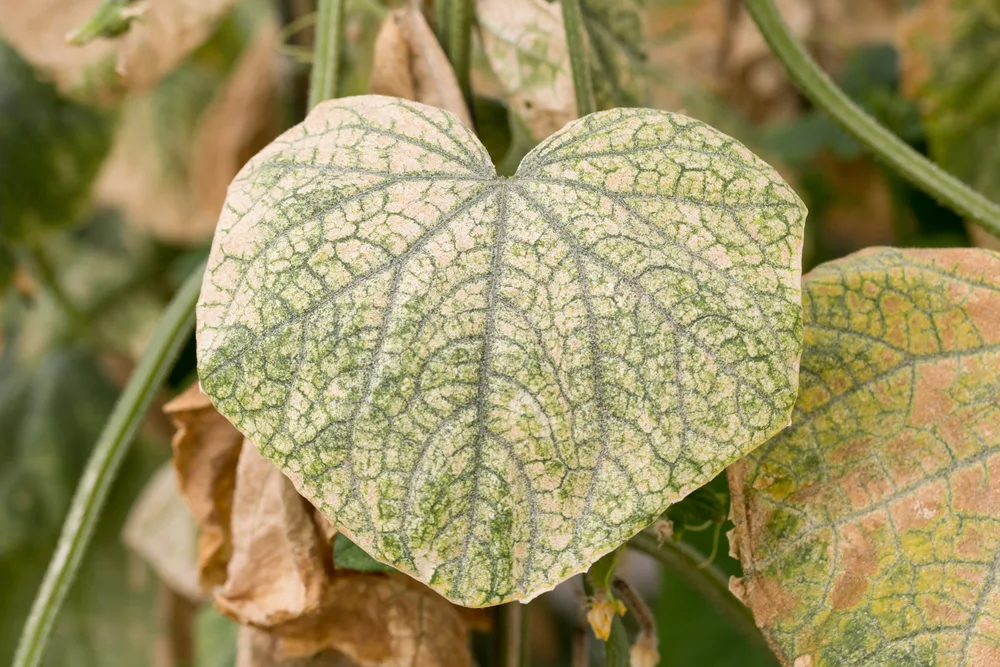
Luckily, the damage they cause is distinct, making it slightly easier to detect. Make checking the underside of leaves a regular part of your gardening routine to know whether they’ve taken hold of your plants.
Spider mite infestations usually call for insecticides, but introducing their predators is a great natural way to get rid of them.
Phytoseiulus persimilis is a predatory mite that mitigates spider mite populations. They’re readily available at most garden centers and can simply be released onto your cucumber crops.
8. Defoliation And Mold – Whiteflies
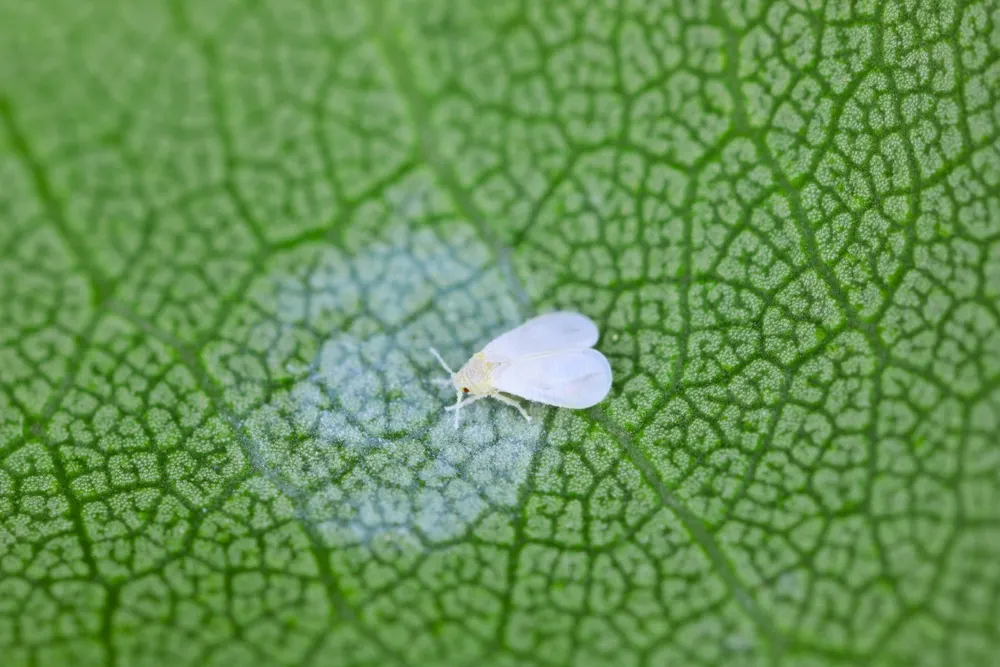
Seasoned green thumbs are probably very familiar with whiteflies. These little flies love cucumbers as much as we do.
They munch on the plant’s sap, which eventually weakens the plant. As they eat the sap, whiteflies excrete a sticky substance called honeydew. This honeydew leads to several issues, including the development of a sooty mold that takes over the leaves.
Whiteflies not only weaken plants and cause the growth of sooty mold, but they also carry and introduce several diseases to your garden, which can have devasting effects.
Whiteflies are minuscule, but they gather in groups on the underside of leaves, making them easier to spot. The damage they cause isn’t as prominent as with other pests, but they and the sooty mold they bring do weaken your plants, resulting in smaller yields.
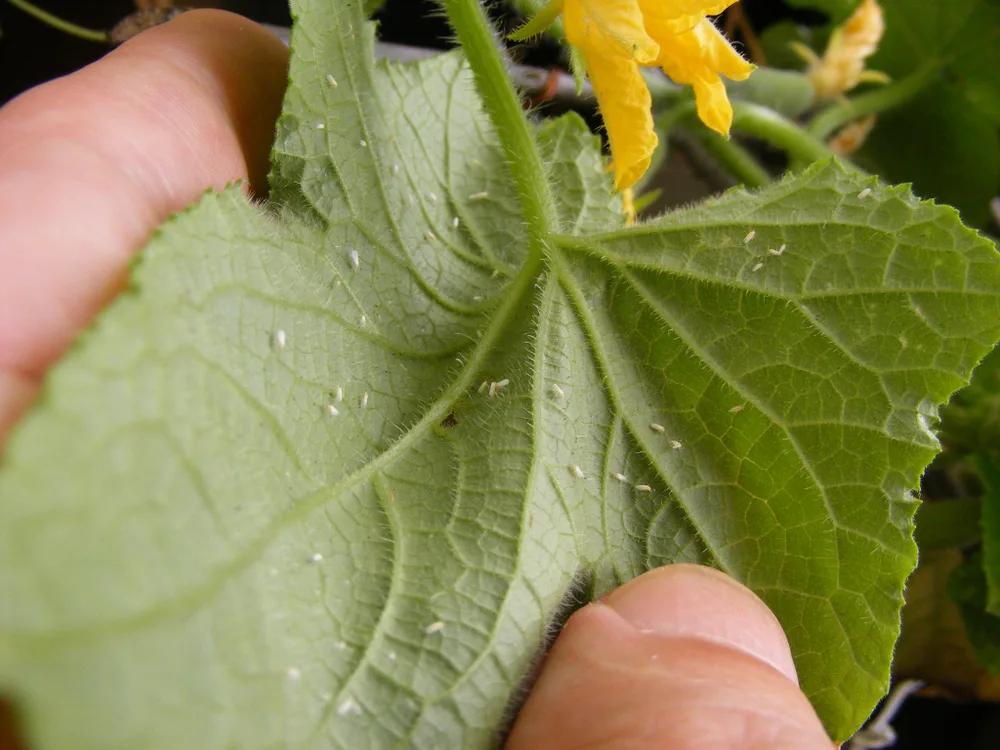
Luckily, whiteflies are relatively easy to deal with and manage.
One of the easiest, and most natural, forms of control is introducing natural predators to your garden.
Ladybugs are a great addition to gardens as they munch on several insects, namely aphids and whiteflies. They’re available at most garden centers and can be attracted to your garden by planting colorful plants like marigolds. Check this tutorial out on how to release ladybugs in your garden.
Horticultural oils are great alternatives to store-bought insecticides. They suffocate whiteflies during any stage of life, but they do tend to deter beneficial insects like bees and even ladybugs.
9. Mottled Colored Leaves And White Fruits – Cucumber Mosaic Virus
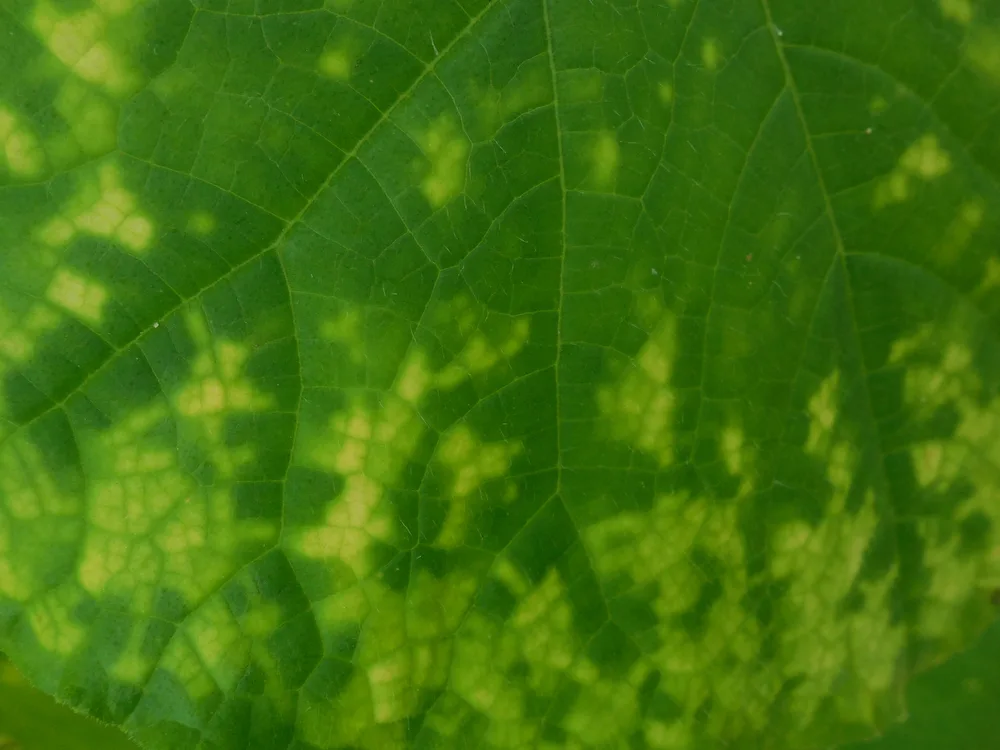
The cucumber mosaic virus is one of the many types of mosaic viruses that attack vegetables.
This virus is spread and introduced into gardens by aphids. Unlike other mosaic viruses, the cucumber mosaic virus doesn’t overwinter in soil and plant debris, nor does it infect new seeds.
Cucumber mosaic virus symptoms first appear during the most vigorous period of growth. This is usually around the six-week mark.
Initially, the leaves develop speckles of white, yellow, and green spots, creating a mottled mosaic pattern across the surface. If left unattended, plant growth becomes severely stunted and few flowers bloom, impacting yield.
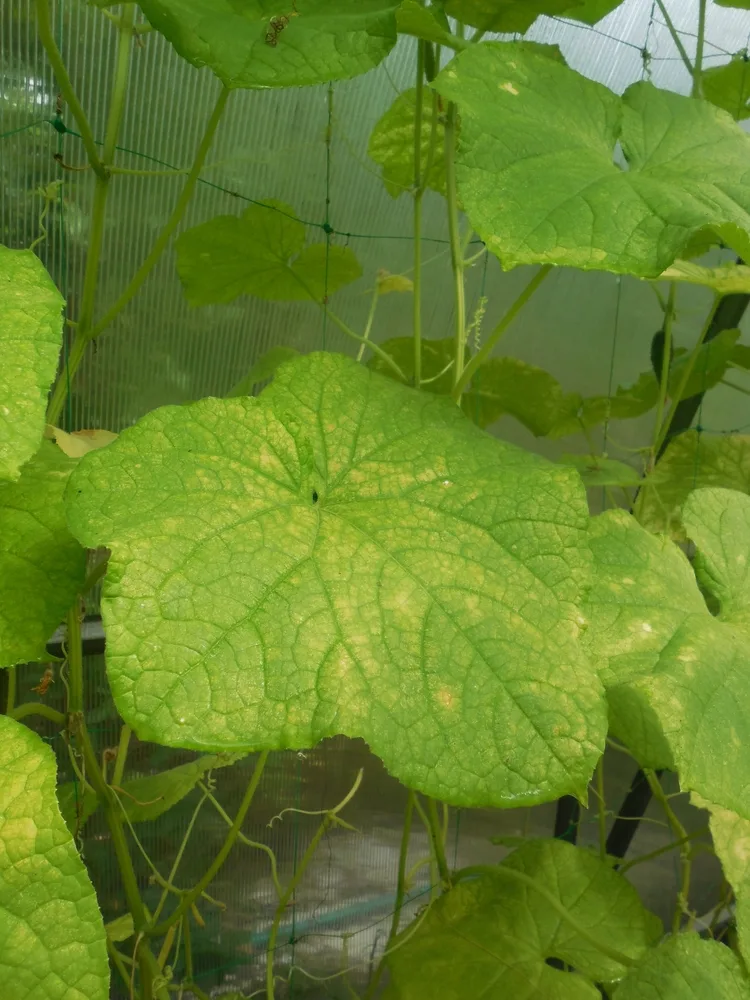
If any cucumbers do grow, they’re a sickly grey-white color instead of green and are aptly called ‘white pickles.’
Unfortunately, there is no fix for the cucumber mosaic virus. If you spot cucumber mosaic virus symptoms on your plants, it’s best to uproot them and destroy them. Do not compost them.
The best way to prevent this destructive disease from killing off your plants is by stopping an aphid colony from becoming too comfortable in your garden. Read on to find out exactly how.
10. White Fluffy/Powdery Appearance On Leaves – Powdery Mildew
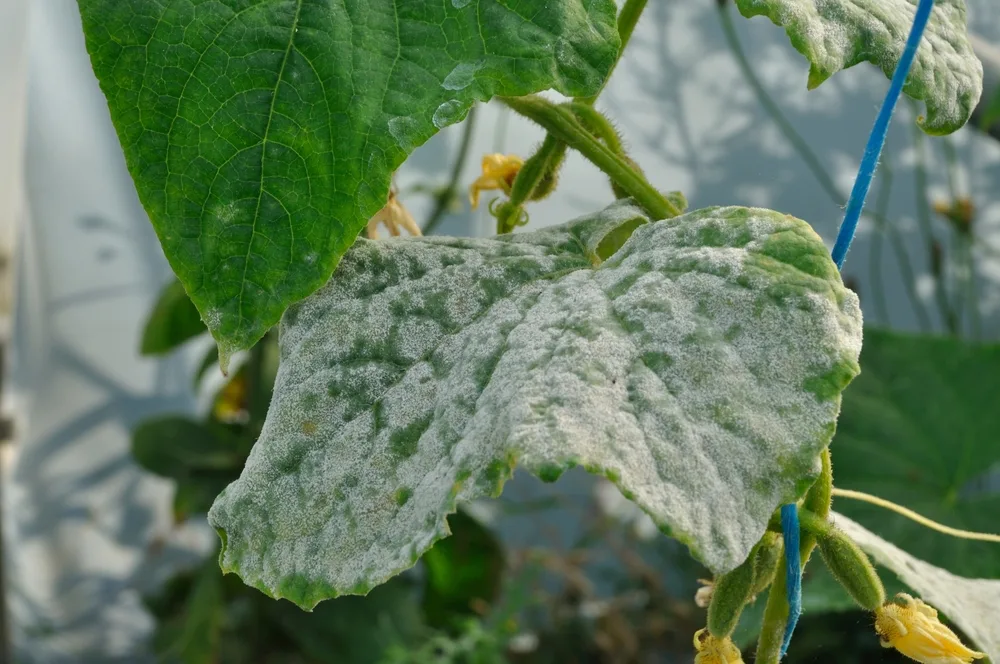
Powdery mildew is yet another common fungal disease. Powdery mildew is caused by the fungus Podosphaera xanthii and it can infect several plants, from your favorite blossoms to your cucumbers.
As with most fungal diseases, powdery mildew thrives in moist and humid conditions and often spreads due to bad watering habits.
Powdery mildew typically affects the foliage of cucumber plants. At first, small yellow spots appear across the surface of the leaves. As the disease progresses these spots become white and enlarge.
Eventually, these spots grow to cover the entire leaves, and sometimes they can spread to the stems of the plant. Powdery mildew ultimately weakens the entire plant, negatively affecting cucumber yields.
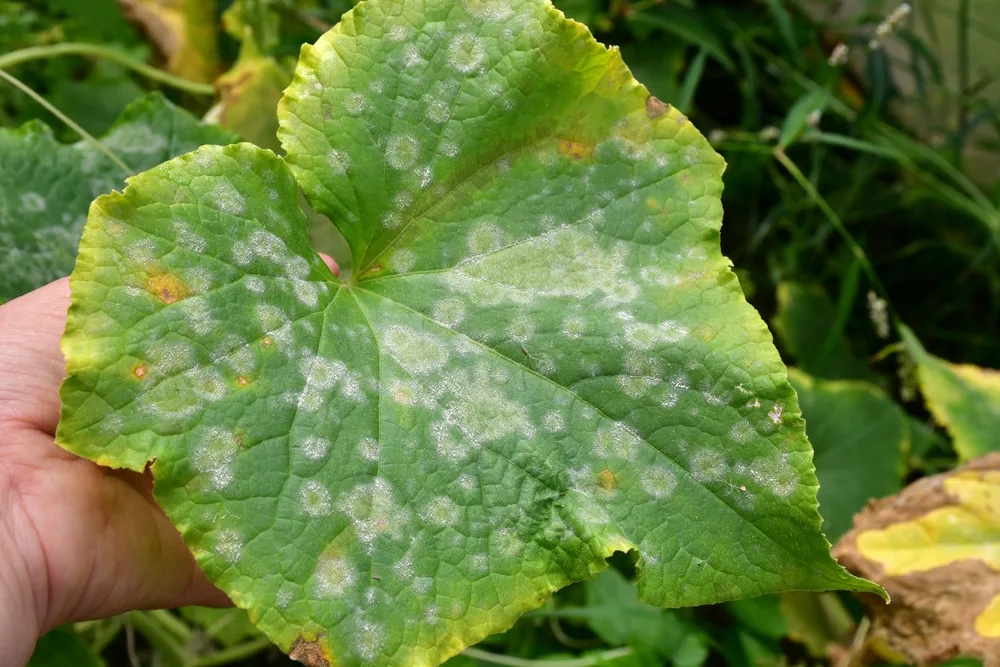
While powdery mildew can have devastating effects on your cucumber plants, there are ways to control and prevent it.
There are several home remedies that you can cook up to help clear powdery mildew from your cucumber plants. Baking soda mixed with water and mild soap makes a wonderful spray that not only helps get rid of powdery mildew but also prevents it.
Horticultural oils like neem oil are another great natural option that eases the effects and helps prevent this disease.
Powdery mildew is just as easy to prevent. Ensure that your cucumbers have plenty of airflow by pruning regularly and effectively. You can further increase airflow by planting your plants with sufficient space between them.
Good garden hygiene and avoiding overhead watering methods are even more ways to stop powdery mildew from taking root on your cucumber plants.
11. Deformation And Stunted Growth – Aphids
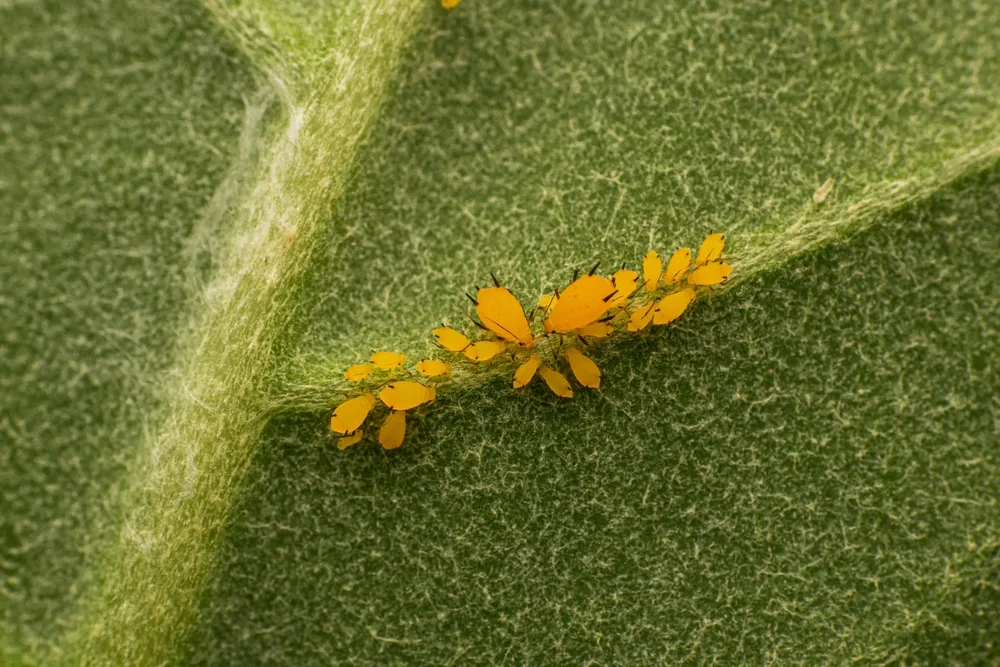
Aphids, aphids, aphids. No list of plant problems seems complete without mentioning them. These pesky little pests seem to attack any plant in the garden, including roses, tomatoes and, you guessed it, cucumbers.
These tiny fly-like bugs nestle on the underside of leaves and suck on their sap. Eventually, these leaves begin to weaken, yellow, and, if given time will die off.
Foliage growth is typically stunted, and, in most cases, cucumber development is negatively affected. Yields are usually decreased and the cucumbers that do grow are often deformed.
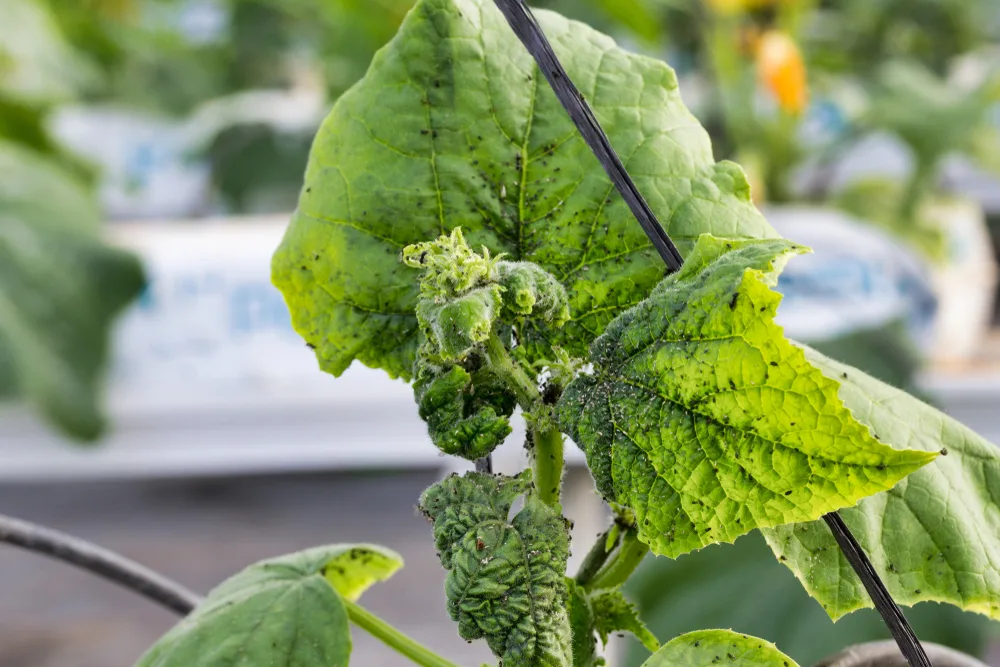
Aphids are also carriers of several devastating diseases, including the previously mentioned mosaic virus.
While these pests may seem daunting, they’re easy to control and prevent if caught early. Make checking the underside of leaves for aphids (and other pests and diseases) part of your daily routine.
If you spot these little bugs, you can simply pick them off your leaves and squish them between your fingers. For larger infestations, you can wipe them off and into a bucket or jar of soapy water.
Horticultural oils also kill these pests off. Alternatively, you can introduce ladybugs, aphid’s natural predator, into your garden.
To stop aphids from settling on your cucumbers, add row covers to your vegetable patch. They keep pests off your cucumbers and other vegetables too.
Cucumbers face several problems, from tiny pests to devastating diseases. Luckily, there are many ways to deal with and, in some cases, prevent these problems. Most times, good garden hygiene and the correct watering methods can make all the difference in the world.

Get the famous Rural Sprout newsletter delivered to your inbox.
Including Sunday ramblings from our editor, Tracey, as well as “What’s Up Wednesday” our roundup of what’s in season and new article updates and alerts.

